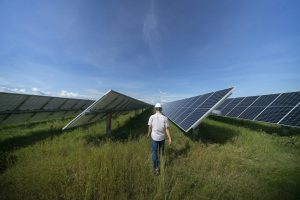1. Renewable Energy Explanation
In any discussion of climate change, renewable energy often tops the list of changes the world can make to avert the worst effects of rising temperatures. That’s because renewable energy sources, such as solar and wind, do not emit carbon dioxide and other greenhouse gases that contribute to global warming.
Clean energy has more to offer than just “green”. The growing sector creates jobs, makes the grid more resilient, expands access to energy in developing countries, and helps reduce electricity bills. All of those factors have contributed to a renewable energy renaissance in recent years, with wind and solar setting new records for electricity generation.

For the past 150 years or so, humans have relied heavily on coal, oil, and other fossil fuels to power everything from light bulbs to cars to factories. Fossil fuels are incorporated into nearly everything we do, and the greenhouse gas emissions from burning those fuels have reached historic highs as a result.
As greenhouse gases trap heat in the atmosphere that would otherwise escape to space, the average surface temperature is rising. Global warming is a symptom of climate change, the term scientists now prefer to describe the complex changes affecting our planet’s weather and climate systems. Climate change includes not only rising average temperatures but also extreme weather events, changes in wildlife.

Of course, renewables – like any energy source – have their own trade-offs and associated debates. One of them focuses on the definition of renewable energy. Strictly speaking, renewable energy is what you might think: readily available, or as the US Energy Information Administration puts it, “virtually inexhaustible”. But “renewable” doesn’t necessarily mean sustainable, as opponents of corn ethanol or large hydroelectric dams often argue. It also excludes other low- or zero-emissions resources that have their own advocates, including energy efficiency and nuclear power.
2. Ways to increase renewable energy
Cities, states and federal governments around the world are establishing policies to increase renewable energy. At least 29 U.S. states have established renewable energy portfolio standards—policies that mandate a certain percentage of energy comes from renewable sources. More than 100 cities worldwide now boast at least 70% of their energy from renewable sources, and still others are committing to 100%. Other policies that could encourage renewable energy growth include carbon pricing, fuel economy standards and building efficiency standards. Corporations are also making a difference, buying record amounts of renewable electricity in 2018.

Wondering if your state will ever be powered by 100% renewable energy? No matter where you live, scientist Mark Jacobson believes it’s possible. That vision is presented here, and while his analysis is not without criticism, it highlights a reality that the world must now take into account. Even without climate change, fossil fuels are a finite resource and if we want the lease on the planet to be renewable, our energy will have to be renewable.



